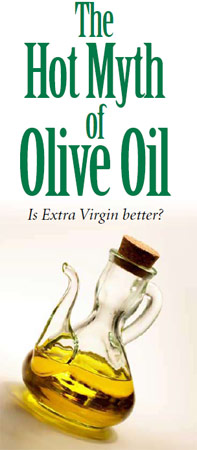 |
 |
 |
|
April 2009
|
The
Hot Myth of Olive Oil So what has made this fruit oil so beguiling that we are prepared to pay up to five times more for it than any of the over thirty different types of available edible oils? Even in these recessionary times, the appearance of several different brands and qualities in supermarkets, ranging in labels from ‘extra-virgin’ to plain ‘olive oil,’ suggests that despite its costliness, it is the new signature ingredient of the modern kitchen. So, is EVOO all it’s cracked up to be, or have we been seduced by shrewd marketing into adopting it as a status symbol? Dr Dan Ramdath, Professor of Biochemistry at The University of the West Indies (UWI) and Registered Nutritionist (UK), remembers olive oil being around in the old days when pharmacies stocked it as sweet oil, used for softening ear wax. A rather mundane Caribbean origin–but one that burgeoned as communications technology let us in on its prominence in the Mediterranean diet and its association with reduced risk for coronary heart disease. Prof Ramdath says that Mediterranean uses of the oil involve light drizzles on salads or brushing it onto fish, meat or vegetables just before serving, and rarely involves heating or frying, but people don’t realise that cooking with the oil actually alters its effects significantly, and so blithely fry everything in it. “When polyunsaturated fatty acids are heated, they absorb oxygen from the air and the process of rancidity is initiated. As the oil is progressively exposed to more oxygen or is heated further it takes up more oxygen and starts smelling rancid. In our bodies, antioxidants such as Vitamin C, E, and carotene prevent our cells from going rancid. In oils, this process is called oxidation and can be prevented to some extent by the use of antioxidants. In addition, the structure of the fatty acids change and these changes can have adverse effects on LDL and HDL and the risk for heart attack,” he says. You can sprinkle practically any kind of oil onto your salads, he says, it really is a matter of taste; and as with everything else, the difference in health benefits has more to do with how much you use. Olive oil might be different from other oils in some ways, but excess is always bad.
“Grapeseed oil is very interesting because recent research has shown that it contains compounds that have beneficial effects on cell growth and antioxidant status. These compounds are similar to those that cause the colouring of most fruits and vegetables (called flavonoids) and have been shown to improve the ability of our body to handle sugar, which is very promising for persons with pre-diabetes or diabetes. Some flavonoids found in grapeseed also stimulate cellular metabolism and help to burn off excess calories in rats, which prevent the onset of diabetes,” he says. Cooks will be happy to know that grapeseed oil has a high smoking point so it can be used to cook at high temperatures: stir-fries and sautés, for instance. And it’s good for your skin too: recommended as an all-over skin moisturizer, said to reduce the visibility of stretch marks, and used as a lubricant for shaving. However, it is fairly expensive as well, roughly three times the cost of vegetable oil. Prof Ramdath contends that there really is no safe, healthy oil, “but rather it is the amount of oils and other fats you consume in your daily meals that is more important.” Most health problems, like hypertension and diabetes, are associated with large waist circumferences–a result mainly of overeating. His advice? Eat less, remove skin and fat from meats, avoid fried foods; try them grilled, barbecued or baked, and watch out for mayonnaise. “The bottom line,” he says, “is to stay away from fats and oils, minimise usage when necessary and use the money spent in buying expensive ‘healthy oils’ to buy more fruits and vegetables, and a good pair of running shoes.” |

 Thanks to 16 years of Food Ne twork’s marketing on cable TV, everyone knows what EVOO is and what’s more, has been persuaded that extra virgin olive oil is the slick, chic way to highfalutin health.
Thanks to 16 years of Food Ne twork’s marketing on cable TV, everyone knows what EVOO is and what’s more, has been persuaded that extra virgin olive oil is the slick, chic way to highfalutin health.
 “The difference is due to the building blocks of dietary fats called fatty acids. Fatty acids can become rancid when exposed to air and this depends on their chemical structure. Those rich in saturated fats like coconut oil are resistant to rancidity. Olive oil is rich in monounsaturated fatty acids, which have been shown to lower LDL (high risk cholesterol) with modest increases in HDL (protective cholesterol). Interestingly, avocado has a fat profile that is similar to olive oil. Other oils (sunflower, or canola, or soya or grapeseed) are predominantly rich in polyunsaturated fatty acids which promote favourable LDL but also reduce HDL; so like all types of oils it is important to use it sparingly,” says Prof Ramdath.
“The difference is due to the building blocks of dietary fats called fatty acids. Fatty acids can become rancid when exposed to air and this depends on their chemical structure. Those rich in saturated fats like coconut oil are resistant to rancidity. Olive oil is rich in monounsaturated fatty acids, which have been shown to lower LDL (high risk cholesterol) with modest increases in HDL (protective cholesterol). Interestingly, avocado has a fat profile that is similar to olive oil. Other oils (sunflower, or canola, or soya or grapeseed) are predominantly rich in polyunsaturated fatty acids which promote favourable LDL but also reduce HDL; so like all types of oils it is important to use it sparingly,” says Prof Ramdath.